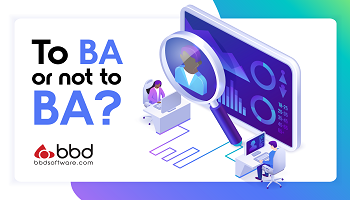
To BA or Not To BA: Why Every Team Needs Business Analysts
The importance of having a business analyst (BA) on your team can’t be overstated. Acting as the bridge between stakeholders and technical teams, the BA wears many different hats. On any given day, a BA can be expected to work on a number of different tasks, whether that’s defining business cases, validating solutions, or even working with data (See this article on the role of BAs in an increasingly data-driven landscape). Able to straddle both worlds and speak the language of businesspeople and techies alike, BAs really are one of the most versatile members of the team.
The Story of an Ask
Many businesses are concerned with their ideal state, while the nitty gritties of how to actually get there are very much back of mind. “Often, the client is not able to fully explain what business problem they wish to solve and how to translate their business requirement into language the technical teams can understand,” explains Lizande Botha, a BBD project manager for a major financial services client in Africa “which is why BAs are a vital part of the process”. Put simply, BAs are responsible for translating a business ask into detailed requirements that can be understood and actioned by technical teams.
But how do we get to this point, when the ask itself is unclear? “The first question I tell the BA to ask the client is: What is the problem we’re trying to solve?” explains Botha, adding that the cardinal role of the BA is to ensure that the client ask is clearly defined. “For clients who really are unsure of what it is they want, the BA needs to keep digging and asking questions to truly get to the core of the problem” she adds.
Advertisement
Once this key piece of information has been gathered, the BA can start drilling down into the different possible solutions, what the budget is for the project, and other confines or expectations the client might have. Understanding the requirements and clearly defining the scope of any given project from the get-go can be make or break – so much so that CIO magazine reports that up to 71% of failed software projects can be attributed to poor requirements. Thus, consulting with a BA at the start of a project can avoid potential stumbling blocks.
While this early engagement is vital, the job of the BA doesn’t start and end there. Leveraging rapport built with business stakeholders, they must check in regularly to provide progress updates, while ensuring that on the engineering side things are running on course and to the requirements of the client’s business. They’re even able to partake in platform or application testing. Truly, the BA’s impact is felt throughout the project lifecycle!
BBD’s Drive to Help and Resolve
BBD’s teams are all complemented with BAs who are well equipped with experience and a thorough understanding of the industry they’re operating in. As each industry offers complexities unique to its environment, BBD strives to best match their analysts to sectors where they can bring their experience and real-life learnings to the table, explains Botha. This is a high priority for BBD, a software solutions company which delivers software solutions for clients across the industry spectrum, from financial, education, public sector, gaming, and beyond. Assigning BA’s that already understand the nuances, jargon and processes of a particular industry enable us to expedite the solution process” says Botha
But beyond managing teams to ensure the best hands are on board, BBD is ready to tackle any problems their clients have. And when it comes to understanding what those problems are, BBD has BAs on call to bridge the client-engineer gap and ensure the success of all of their solutions.
Looking for a software partner to help you on your next ask? Get in touch with BBD.